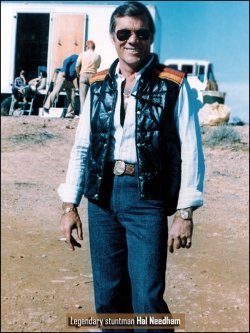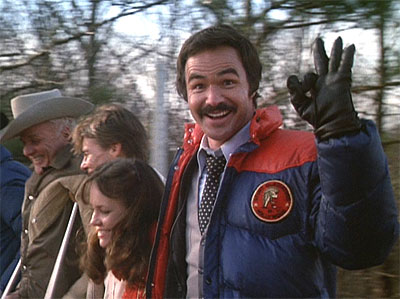
(This is a tag-team appreciation of the great Hal Needham. My pal Mike Ryan has a terrific piece on SMOKEY AND THE BANDIT up at the Huffington Post. Read it now, then come back here for HOOPER!)
When we discuss the major American films of the 1970s, we do not discuss the films of Hal Needham. When the major critics of that era discussed the films of Hal Needham, they did so obligingly at best, noting that his odes to hell raising, bootlegging and vehicular demolition were "brainless in an entertaining way". Others felt his movies represented "an abdication of artistic responsibility at the lowest possible level of ambition". The latter assessment isn't entirely unfair: Needham was hardly a master of mise-en-scene; onscreen, his chaotic car chases felt more captured than choreographed. But "lowest possible level of ambition"? Knocking down a huge wooden roller coaster for a laugh might not be the pinnacle of cinematic achievement, but it certainly requires more than a little chutzpah.
For Needham, ambition was everything. The son of an Arkansas sharecropper, Needham served his country as a paratrooper in the Korean War; upon returning, he made his way to Hollywood, where he became one of the most sought-after stuntmen in the industry. As he details with no shortage of brio in his immensely entertaining memoir STUNTMAN!, Needham repeatedly risked life and limb doubling for some of the biggest movie stars of the '60s and '70s. He broke fifty-six bones over the course of his career (his back twice), and set a insanely perilous, dare-you-to-top-this standard for his colleagues. Cars, airplanes, speedboats, horses... if you could fall from it or jump it over something that ought not be jumped over, Needham wanted on it.
After two decades of nearly getting himself killed for the enjoyment of moviegoers, Needham took a crack at directing with SMOKEY AND THE BANDIT. Initially developed as a low-budget vehicle for country music star Jerry Reed, the project found a home at Universal when Burt Reynolds signed on to play the titular, Trans-Am-driving bootlegger. With country music crossing over into the mainstream, Reynolds at the absolute zenith of his popularity, and comedic genius Jackie Gleason improvising a significant chunk of his dialogue, the film became the second-highest-grossing release of 1977 - even though, according to NEW YORK TIMES critic Janet Maslin, it was a box-office "washout" in New York City. This was a movie for what people now regrettably refer to as the "flyovers". It was a gleefully rambunctious redneck picture backed by a major studio, starring a proud son of the South (though he was born in Michigan) and a guy from Bushwick who could do a mean Southern accent. And while it celebrated car culture at a time when Americans were getting killed at the pump, it was utterly apolitical. If SMOKEY AND THE BANDIT is about anything other than giving audiences their money's worth, it's about the right to drive really fucking fast and sticking it to every dipshit deputy who ever gave you a speeding ticket.
Riding high on the success of his debut movie, Needham wasted no time delving into his passion project, and what, to my mind, stands as one of the most underrated entertainments of the '70s. Though HOOPER, Needham's second big-screen team-up with Reynolds, was a massive hit in 1978, it is rarely referenced nowadays due largely to reasons of availability. An affectionate tribute to the rough-and-tumble lives of stuntmen, HOOPER has generally been treated by Warner Bros. as a celluloid leper. It was difficult to find on VHS in the '90s, and is available now only in a full-screen transfer on a "Triple Feature" DVD with SHARKEY'S MACHINE and STROKER ACE. I could be wrong, but I'm pretty sure that, over the last decade, it's never received a 35mm repertory screening in Los Angeles. It's practically an obscurity in 2012. When I discuss the film with fellow movie lovers, I often find myself having to remind them of its major set pieces. "Oh, that's right! The rocket car! The Terry Bradshaw fight! Wow, I *loved* that when I was a kid!"

I still love HOOPER. It's the first film about filmmaking I ever saw, and, unlike its cynical subgenre brethren (everything from THE BAD AND THE BEAUTIFUL to THE PLAYER and beyond), it dares to depict the movie production as a full-throttle blast. The movie pits Reynolds's Sonny Hooper against a pretentious auteur named Roger Deal (a wicked Peter Bogdanovich parody pompously embodied by Robert Klein), who's directing a big-budget spy thriller like it's LA STRADA. The aging daredevil is also in competition with a younger stuntman, Ski (Jan-Michael Vincent), whose lack of bodily mileage allows him to execute feats that should be off limits to Hooper. This doesn't stop Hooper from pulling off a 224-foot freefall (close to the height from which Reynolds would ask stunt legend Dar Robinson to plummet in SHARKEY'S MACHINE), but his doctor has warned him that he's one errant jolt away from paralysis or death. "If you were a horse," advises the physician, "I'd shoot you."
HOOPER pulsates with the good-ol'-boy charm of Needham's most notable films, but the brawling energy is deftly undercut by an end-of-an-era wistfulness. At the time of the film's release, directors and producers were clamoring for more from their stuntpeople - to the point where they misguidedly began selling films on the stunts. A few years after the shooting of HOOPER, Robinson would drop an insane 700 feet from Toronto's CN Tower for a largely forgotten thriller called HIGHPOINT. It's a breathtakingly dangerous undertaking, but visually unimpressive; you know what you're watching is real, but you never sense the danger.
This was never the case in a Needham film. Though the director has been criticized for filming his cataclysmic car chases without panache, he covers the action from every conceivable angle, placing the viewer right in harm's way with Sonny and Ski. And the stunts aren't boring old free falls; the grand finale in HOOPER is an exhilaratingly-staged obstacle course of a sequence that would never, ever be attempted in a studio film today (though I'm sure Michael Bay and Peter Berg would love to give it a go). Crumbling buildings, tumbling smokestacks, explosions at every turn... it's madness. And that's partially the point of HOOPER: these fearless professionals are being asked to do way too much, but they'll do it because backing down would kick open the door for the next-hungriest guy. It's that one-upsmanship thing. You think you can clear this twenty-foot gulch? How about over there where it's a thirty-foot gap? Ask, and it shall be attempted. It's up to the director to not be so precious or determined that he puts his stuntpeople at undue risk.
HOOPER is Needham's love letter to the profession that gave him his career. Today, it also works as a fond look back at a time when peril couldn't be fabricated with CG. Perhaps it's progress that filmmakers no longer have to rely on some crazy bastard's lack of concern for his own well being to get a shot of a bad guy falling from a skyscraper. I just know that there's no substitute for the real thing - and throughout his career as a stuntman and a director, Needham was as real as it got. But it was all good-natured rowdiness with Needham. This is exemplified by the barroom brawl in HOOPER, which ends with the combatants laughing off their bruises and congratulating each other on throwing a good punch. Sometimes you just need to raise a little hell.
There's really no analyzing a Hal Needham movie - no subtext to tease out or elegantly-staged set piece to break down. They are precisely what they are. We don't deconstruct Hal Needham films. We enjoy them.
Faithfully submitted,
